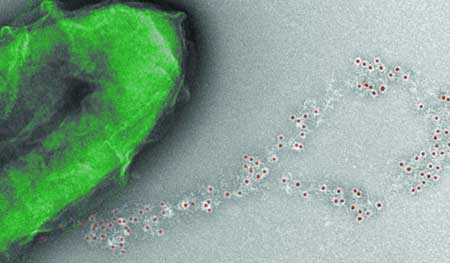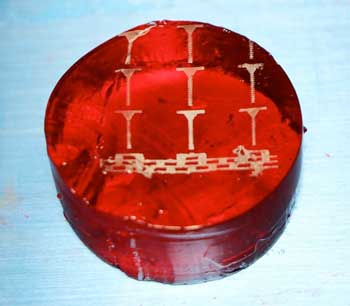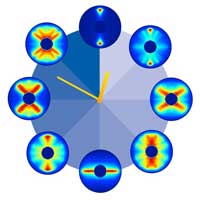 Scientists report 'a major advance' in the quest to develop electrically conductive protein nanowires in the bacterium Geobacter sulfurreducens for use as chemical and biological sensors.
Scientists report 'a major advance' in the quest to develop electrically conductive protein nanowires in the bacterium Geobacter sulfurreducens for use as chemical and biological sensors.
Monday, July 29, 2019
Expanding functions of conducting microbial nanowires for chemical, biological sensors
 Scientists report 'a major advance' in the quest to develop electrically conductive protein nanowires in the bacterium Geobacter sulfurreducens for use as chemical and biological sensors.
Scientists report 'a major advance' in the quest to develop electrically conductive protein nanowires in the bacterium Geobacter sulfurreducens for use as chemical and biological sensors.
Oddball edge wins nanotube faceoff
 Theory shows peculiar ?Janus? interface a common mechanism in carbon nanotube growth.
Theory shows peculiar ?Janus? interface a common mechanism in carbon nanotube growth.
Engineers use heat-free tech for flexible electronics; print metal on flowers, gelatin
 Researchers are using liquid-metal particles to print electronic lines and traces on rose petals, leaves, paper, gelatin - on all kinds of materials. The technology creates flexible electronics that could have many applications such as monitoring crops, tracking a building's structural integrity or collecting biological data.
Researchers are using liquid-metal particles to print electronic lines and traces on rose petals, leaves, paper, gelatin - on all kinds of materials. The technology creates flexible electronics that could have many applications such as monitoring crops, tracking a building's structural integrity or collecting biological data.
Dynamics in quantum dots: Smallest measurable processes recorded individually
 Colloquially, the term 'quantum jump' is used to describe a tremendous development. In fact, it is the smallest change of state that can still be traced. Physicists have now succeeded in measuring every single jump by optical means and drawing conclusions about the dynamics of the electrons inside a quantum dot.
Colloquially, the term 'quantum jump' is used to describe a tremendous development. In fact, it is the smallest change of state that can still be traced. Physicists have now succeeded in measuring every single jump by optical means and drawing conclusions about the dynamics of the electrons inside a quantum dot.
Transforming advanced nanoscience data into interactive art
 Scientists and a multimedia artist generated novel representations of experimental nanoscience data through 3-D printing, sound, and virtual reality.
Scientists and a multimedia artist generated novel representations of experimental nanoscience data through 3-D printing, sound, and virtual reality.
Travelling towards a quantum internet at light speed
 Scientists successfully transferred and verified the angular momentum basis of quantum information from laser light to an electron trapped on a quantum dot. This work is a major step towards realizing hacker-proof interconnected quantum computers.
Scientists successfully transferred and verified the angular momentum basis of quantum information from laser light to an electron trapped on a quantum dot. This work is a major step towards realizing hacker-proof interconnected quantum computers.
Scientists film molecular rotation
 Quantum movie displays probability density distribution of rotating carbonyl sulphide molecules.
Quantum movie displays probability density distribution of rotating carbonyl sulphide molecules.
Subscribe to:
Comments (Atom)
